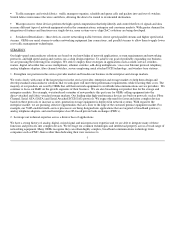Adaptec 2004 Annual Report Download - page 16
Download and view the complete annual report
Please find page 16 of the 2004 Adaptec annual report below. You can navigate through the pages in the report by either clicking on the pages listed below, or by using the keyword search tool below to find specific information within the annual report.
OEMs also consider the quality of the supplier when determining which component to include in a design. Many of our customers
will consider the breadth and depth of the supplier’s technology, as using one supplier for a broad range of technologies can often
simplify and accelerate the design of next generation equipment. OEMs will also consider a supplier’s design execution reputation, as
many OEMs design their next generation equipment concurrently with the semiconductor component design. OEMs also consider
whether a supplier has been pre−qualified, as this ensures that components made by that supplier will meet the OEM’s quality
standards.
Our competitors can be classified into two major groups. First, we compete against established peer−group semiconductor companies
that focus on the communications semiconductor business. These companies include Agere Systems, Applied Micro Circuits
Corporation, Broadcom, Conexant Systems, Emulex, Exar Corporation, Freescale Semiconductors, LSI Logic Corporation, Marvell
Technology Group, Mindspeed Technologies, Qlogic, Silicon Image, Transwitch and Vitesse Semiconductor. Many of these
companies are well financed, have significant communications semiconductor technology assets and established sales channels, and
depend on the market in which we participate for the bulk of their revenues.
Second, we also compete with major domestic and international semiconductor companies, including Agilent, Cypress
Semiconductor, Intel, IBM, Infineon, Integrated Device Technology, Maxim Integrated Products, and Texas Instruments. Some of
these companies are concentrating an increasing amount of their substantial financial and other resources on the markets in which we
participate.
Over the next few years, it is possible for additional competitors to enter the market with new products, some of which may also have
greater financial and other resources than us.
We are also continuing to expand into certain markets, such as storage, wireless infrastructure and general purpose microprocessors,
that have established incumbents with substantial financial and other resources. Some of these incumbents derive a majority of their
earnings from these markets. We expect continued strong competition in these markets.
LICENSES, PATENTS AND TRADEMARKS
We rely in part on patents to protect our intellectual property and have been awarded 167 U.S. and 77 foreign patents for circuit
designs and other innovations used in the design and architecture of our products. In addition, we have 80 patent applications pending
in the U.S. Patent and Trademark office. Our patents typically expire 20 years from the patent application date, with our existing
patents expiring between 2010 and 2022.
We do not consider our business to be materially dependent upon any one patent. We believe that a strong portfolio of patents
combined with other factors such as our ability to innovate, technological expertise and the experience of our personnel are important
to compete effectively in our industry. Our patent portfolio also provides the flexibility to negotiate or cross license intellectual
property with other semiconductor companies to broaden the features in our products.
To protect our other intellectual property we rely on mask work protection, trademarks, copyrights, trade secret laws, employee and
third−party nondisclosure agreements, and
12
























